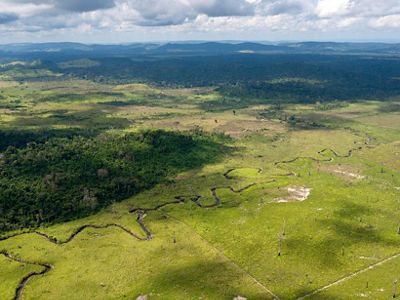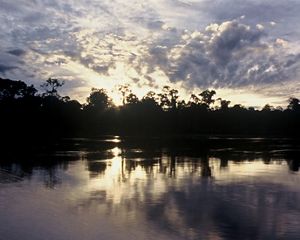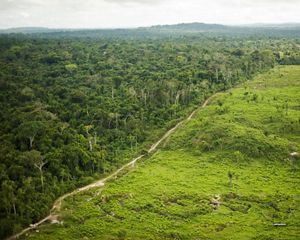The Amazon and Climate Ambition
If implemented, new environmental legislation could help advance Brazil's climate goals and diversify its development opportunities.
By Ian Thompson, Executive Director, TNC Brazil
Known as the lungs of the planet, the Amazon fans out across 60 percent of Brazil, a territory that represents 40 percent of the world's tropical forests. But while it is capable of mitigating more than 49 billion tons of carbon and playing a strategic role in addressing the climate emergency and the country's development, Brazil has yet to show significant ambition for doing so.
Currently, Brazil certifies about 5 million tons of carbon reductions each year, but it has the potential to certify 1.5 billion, or 300 times the current amount. Given the price of carbon recently reached US$41 per ton in the European regulated market, robust trade could involve tens of billions of dollars in credits.
But it's impossible to reach that potential with rates of deforestation and fires such as those observed in 2020, when Brazil lost around 2.7 million acres of Amazonian forest, an area equivalent to almost nine times that of the city of Los Angeles. The Brazilian commitment made at the UN climate convention for that period was around 741,316 acres. Unfortunately, Brazil hasn’t come close to honoring its environmental goals since 2012, when regional deforestation dipped to 1.1 million acres.
At the Climate Ambition Summit in 2020, Brazil weakened its 2030 national target after reviewing its base-year inventory. It presented the possibility of achieving climate neutrality by 2060, making it conditional, however, on some $10 billion of annual funding from rich economies to help its decarbonization efforts.
Indeed, the Paris Agreement makes way for international financing to aid emerging economies, but Brazil has not presented a clear and robust plan for ramping up its climate ambition while guaranteeing transparency and governance for such investments. And there is reason for concern: the country has been slow to act on illegal deforestation, especially in the Amazon, which has helped make it the sixth-largest emitter of greenhouse gases in the world.

The sectors that rely on the Amazon have yet to strike the necessary balance between wealth generation and environmental conservation, neglecting concrete solutions that could drive inclusive and sustainable development. The COVID-19 pandemic further aggravated the challenges posed by increased fires and deforestation in 2020.
The complicated environmental landscape we see today, based on the "extractive economy," originated much earlier. The colonial period took the forest's riches to Europe, before giving way to the disorganized rubber-extraction boom, which fueled the birth of the automobile industry. Mainly between 1968 and 1973, we experienced the "economic miracle" that established the economic dynamics of large infrastructure and mining projects, along with territorial occupation through timber and agricultural enterprises, resulting in significant social and environmental impacts. Even today, a large part of land use is based on the belief that cutting down the forest generates more value and that the legal reserve provided for in the nation’s forest code is a barrier to the full economic use of properties.
In the 1990s and the beginning of the 21st century, the worsening ecological scenario demanded an extreme model of sustainability that was restrictive of the use of natural resources. That generated more social and economic imbalance and did not meet local development's demands. These factors have resulted in territorial and environmental governance that is very susceptible to political changes and resistant to innovations that allow prosperity and local advances.
Quote
Nature-based Solutions could be a tool for transformation—the Amazon’s unique landscape could enable a carbon market that encourages innovation and a greener, more socially inclusive economy.
But one cannot deny that despite the challenges 2020 presented, there have been some advances. The state jurisdictions that cover the Amazon especially have generated development opportunities in the region and resulted in plans, programs, and policies that understand the climatic urgency the world is facing. Nature-based Solutions (NbS) could be a tool for territory transformation—we could leverage the potential of the Amazon’s unique landscape to enable a carbon market that encourages innovation and a greener, more socially inclusive economy.
If implemented, Brazil's new environmental legislation would provide the necessary framework to further its climate ambition and, at the same time, diversify and increase development opportunities. The challenge lies in establishing a collaborative platform for action that permits systemic transformation that takes into consideration the barriers and needs of social, economic, environmental, and climate development. There are three basic keys to this transformation: technology and innovation, science-based policies, and technical and qualified training.
These pillars, along with financing that includes socio-environmental criteria and safeguards, environmental compliance, land titling, and the strengthening of command-and-control actions create conditions for greater climate ambition. They also generate payment opportunities for avoided deforestation and the commercialization of generated carbon credits.
The Leaders’ Summit on Climate, scheduled to be hosted by the new U.S. administration on Earth Day, will offer Brazil a renewed opportunity to demonstrate commitment to results and effective plans for the Amazon that guarantee more ambitious emission-reduction goals and add to the global effort to contain the climate emergency scenario. Surely the world has missed many an opportunity to keep climate change in check, but the second-chance is certainly now.
Originally published in Valor Econômico (Portuguese)
April 19, 2021
View Original
Global Insights
Check out our latest thinking and real-world solutions to some of the most complex challenges facing people and the planet today.



